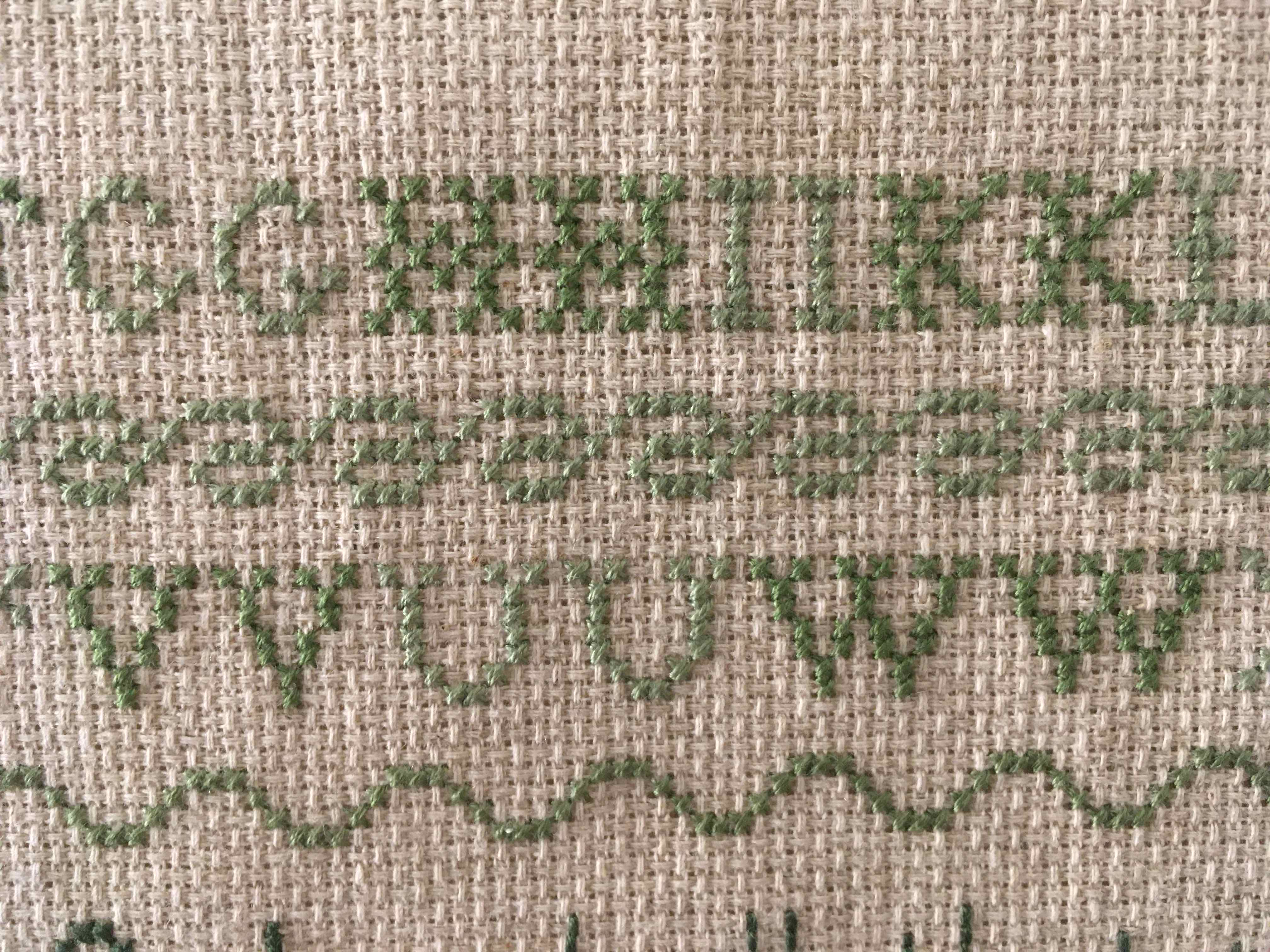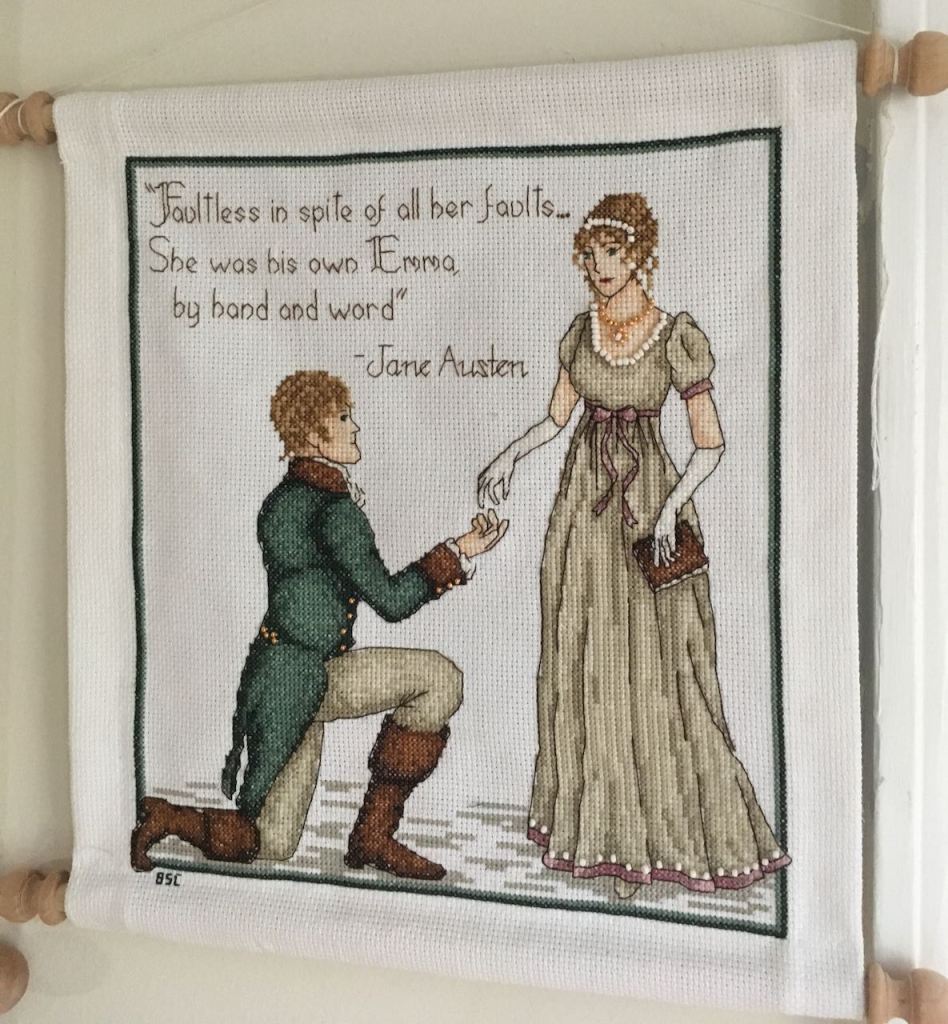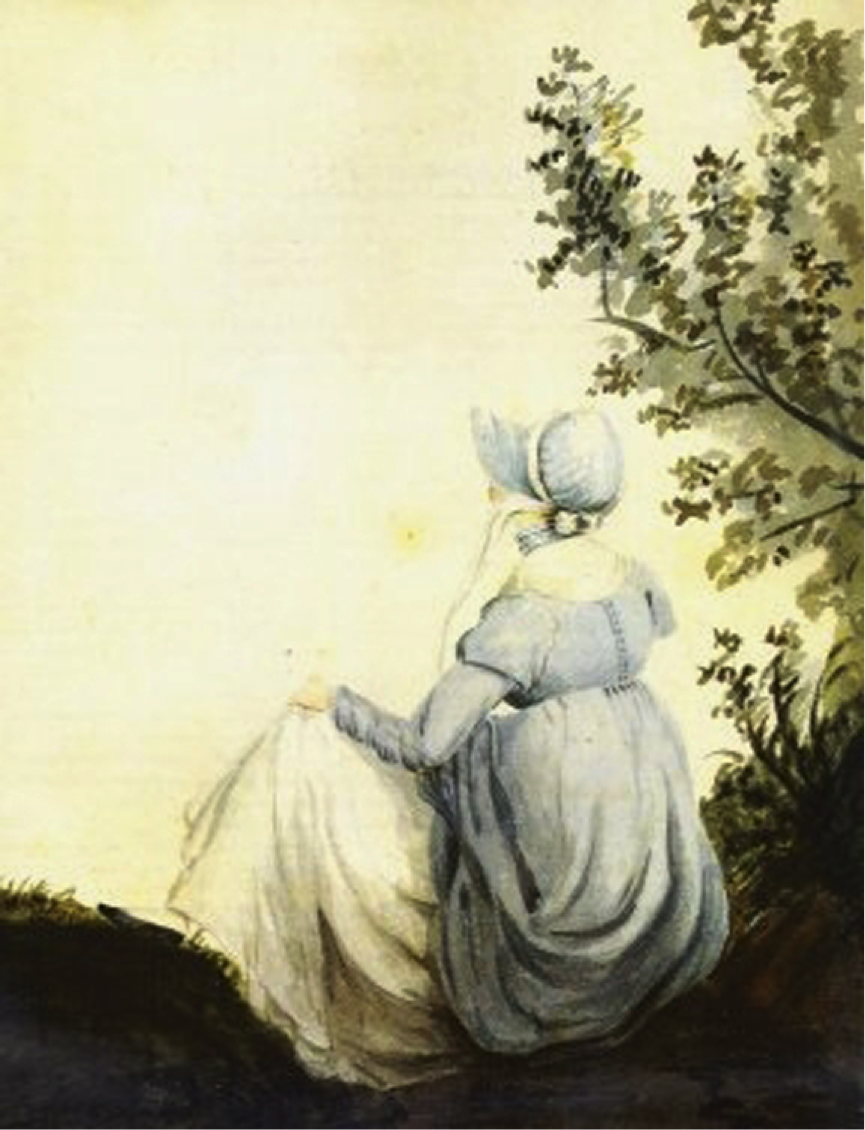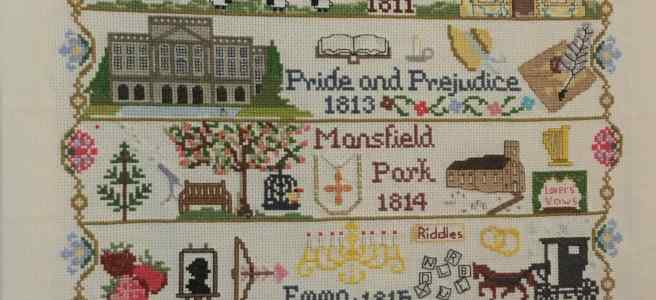Jane Austen-related Sewing and Cross-Stitch Projects
By Brenda S. Cox
“Her [Jane Austen’s] needlework both plain and ornamental was excellent.”–Austen’s nephew
I love Jane Austen, and I love to cross-stitch. Combining those two loves is a great joy for me!
Jane Austen and Embroidery
I just watched a fascinating talk on “Jane Austen & Embroidery,” by Jennie Batchelor, as part of the Chawton Lockdown Literary Festival. Check it out; it may still be on youtube. The book Jane Austen Embroidery by Jennie Batchelor and Alison Larkin is due out today. I don’t know if it includes any cross-stitch, but there are many types of embroidery projects in the book, adapted for modern tastes and uses; it looks very fun! Ms. Batchelor pointed out some of the following ideas:
Jane Austen loved embroidery and sewing, and was proud of her skills. Many of her letters mention her sewing projects. Her nephew wrote:
“Her needlework both plain and ornamental was excellent, and might almost have put a sewing machine to shame. She was considered especially great in satin stitch. She spent much time in these occupations, and some of her merriest talk was over clothes which she and her companions were making, sometimes for themselves, and sometimes for the poor” (A Memoir of Jane Austen by James Edward Austen-Leigh, chapter 5).
Needlework was such a common occupation for women that it was simply called “work.” According to Batchelor, some women of the time, like Mary Wollstonecraft, found needlework limiting. They felt that it repressed women, keeping their hands busy while their minds languished. Perhaps she was thinking of women like Lady Bertram, who “was a woman who spent her days in sitting, nicely dressed, on a sofa, doing some long piece of needlework, of little use and no beauty, thinking more of her pug than her children,” and felt her time well-spent when “she had done a great deal of carpet-work, and made many yards of fringe,” though she had not even noticed her children’s behavior (Mansfield Park chapters 2 and 19).
Jane Austen, however, like many of us today, found that needlework freed up her mind to think creatively.
According to Jane Austen: Her Life and Letters, Austen’s niece Marianne Knight remembered that, “Aunt Jane . . . would sit very quietly at work beside the fire in the Godmersham library, then suddenly burst out laughing, jump up, cross the room to a distant table with papers lying upon it, write something down, returning presently and sitting down quietly to her work again.”
It seems that Austen’s “work”—her needlework—enabled her to think of new ideas, and presumably add more to her novel in progress!
I’ve been enjoying stitching projects related to Jane Austen, which I want to share with you today. If you’re not a stitcher yourself, feel free to just skim the rest or just enjoy the pictures.
Jane Austen Sampler Project

I recently finished this copy of the “Jane Austen Sampler” from Inspired Needleworks. If you’ve been following this blog—or Jane Austen’s World—you know that historical expert Alden O’Brien recently tracked down the source of this sampler and it’s not by “our” Jane Austen, but rather by a different Jane Austen living at the same time. Check out Alden’s post, “Is This Jane Austen’s Sampler?” for the details. Still, the sampler is a lovely piece from that period and I enjoyed stitching it.
Letters of the Alphabet
The alphabet at the top of the sampler held several surprises, and Ms. O’Brien, an expert on embroidery of this time period, explained those to me. Below are my observations followed by my summary of her response to each.
- There is an “I” but no “J.”
–This was common in the eighteenth century. The J was omitted in alphabets until about 1800. I and J were considered to be the same letter, even though they looked different in books and were used differently. Ms. O’Brien adds that this is why there is no “J” street in Washington, D.C., where the streets are named by letters!

- The “V” is before the “U.”
–V and U were also considered the same letter, and many samplers only have a V and not a U. However, putting V before U in this sampler may have simply been an error.
- The capital “Q’s” look like backwards “P’s”—basically like lower-case q’s moved higher. (In looking at my original print, I thought this was a mistake and the P’s were backwards. However, that’s because the light green used for some of the letters is so light that I couldn’t see the actual P’s.)

–Ms. O’Brien says Q’s were stitched like this in samplers for a long time, all the way to the mid-1830s. A few rounded Q’s with tails appear earlier—Alden found an example in 1798—but most use this form that looks like a backwards P.
My Modifications to the Sampler Pattern
(This section is just for stitchers! Skip it if you’re not.)
I followed a pattern from Inspired Needleworks for this sampler, which I highly recommend. They put a great deal of work into deciphering the original sampler and creating this pattern! You can request a digital pattern.
I made a few modifications to make it easier for myself. (That also make the sampler less authentic, sorry!)
- Fabric: Instead of 26-count linen, I used 14-count Aida linen fabric. This made it much easier to do the capital letters, border, and pictures. However, it made the lower-case letters more difficult, as they were made with half-stitches on the 14-count fabric. The finished size on 14-count is 17 ½” high by 15 ½” wide.
- Lower-case letters: The original lower-case letters were made of tiny cross-stitches, so small that they looked like a solid satin stitch once they were stitched. After awhile I did get the hang of making them. However, they were tough on my eyes and back. So, I made the capitalized words (like Praise, Name, etc.) properly, with cross-stitched lower-case letters. But, for the uncapitalized words, I substituted back-stitched letters, in approximately the same shapes. That was much easier and quicker, though not as authentic.

- Colors: I used somewhat darker greens than the pattern called for, so they would show up better on the linen background. I figured that the original greens must have been brighter in any case and faded over the years, since the lightest green is barely visible in the print I have. So for the two lightest greens I used DMC 3363 and 522, instead of 522 and 524. For the flowers, the pattern gives the option of rose or pink, and I used rose, which looks more like the original.
Works of Jane Austen Stitch-Along Project

My previous joyful Jane Austen project was this lovely piece by LeighAnn Kopans. The pattern is available from Etsy. There is also a Facebook group, as it was originally offered as a stitch-along. If you buy the pattern and join the Facebook group, you can scroll down and find patterns for the modifications that various members developed, including the ones that I did. We received a new section of the pattern every six weeks.
I’ve never done a stitch-along before, but it was very fun! I learned a lot from various members of the group. One of my favorites was the idea of using a needle minder, a magnet attaching to the fabric, which holds my needle when I’m not using it. I bought this one from Etsy, where you can find a variety of Jane Austen needle minders (though I don’t think this one is currently available). I actually liked that mine says Pride and Prejudice while it shows a picture from Persuasion, thus combining two of my favorite novels!

My modifications to the Works of Jane Austen pattern
(This section is only for those who like the details!)
- Sense and Sensibility: This strip, and the border, were stitched completely according to the pattern. The cottage is lovely, and the lock of hair and the scissors with a “scissors minder” are a delight.
- Pride and Prejudice: One member of the group, Debbie Wilson, created this version of Pemberley based on the iconic movie, including a lake in front and Darcy’s head sticking out of the water! The rest follows the pattern.
- Mansfield Park: This novel includes two of my favorite themes, faith and science, and so I modified the pattern greatly. I added a picture of Chawton Church (as it was when Jane lived in Chawton), Fanny’s cross with the two chains, the telescope and constellations mentioned in the novel, and an evergreen for Fanny’s rhapsodies on the evergreen. The “Lover’s Vows” stage is reduced in size from a stage created by a member of the Facebook group, Donna Hubbard Beck. The rest is from the pattern.

- Emma: puzzles, riddles, and mysteries are threaded through the novel. So I added a “Riddles” section (on a bookmark, to represent Emma and Harriet’s book, and some of the letters that Frank, Jane, and Emma untangled (again based on a pattern added to the FB group by Donna Hubbard Beck).
- Northanger Abbey: I added some crosses to the abbey, to make it look a bit more like a place that once had been a center of worship. The Pump Room sign and the key design come from others in the FB group. I added the hyacinth, which Catherine learned to love!
- Persuasion: Leigh’s picture of the ship and lighthouse is gorgeous; worth the price of the pattern in itself! I changed the house to make it like the house in Bath, in Camden Place, where the Elliots lived.
And that’s it; great fun! I hung both projects on dowels which I found at Hobby Lobby. It makes them portable.
Perfectly Imperfect Project
For the future, I have this gorgeous pattern to do someday, from Cross Stitch Collection, Feb. 2017. It’s available digitally.

I didn’t notice until after I had bought it, but the quote, “Perhaps it is our imperfections that make us so perfect for one another” is not actually by Jane Austen. It’s from one of the movie versions of Emma! (1996, I think.) I still like it, though. I might use that quote, or I might substitute another of my favorite quotes, from one of the books. The picture could work for any of the books, really. The pattern uses gold and white beads, which I think will make a lovely touch.
Another project I’d love to do is a kit from Bothy Threads, available through the Jane Austen Centre in Bath, on Etsy, and other sources. It has cartoon-style characters from each novel. I have a mug with the same pictures.
Knitting Projects
If you knit, Pride and Preju-Knits gives patterns for dolls of Austen’s characters. My daughter is making one for me right now! It’s bigger than I expected—really a full-sized doll. It’s very challenging to knit, she tells me.
Your Ideas and Projects
I’d love for you to share some of your favorite Austen stitching projects, either ones you’ve completed or ones you still want to do! And give us sources for the patterns, please, unless you’ve created them yourself.
Even during challenging times, we can find joy in many ways. How are you finding joy in these days of isolation?




I love Jane Austen and I love to cross-stitch too. During the quarantine I’ve been finding joy in cross-stitching a Jane Austen related project I had myself created last year. Since I am a tea lover, I wished to embroider a teapot and tea cup subject to hang in the kitchen; I thought it would be nice to add an Austen quote having to do with tea, so I chose a short sentence from Sanditon (I was reading that book at the time). I find cross-stitching a calming and “stabilizing” activity for my mind.
Best wishes!
Claudia (Italy)
LikeLike
That sound lovely, Claudia! Feel free to post a picture here of your project, if you’d like to share it. or at least tell us the Sanditon quote! I am now stitching the Perfectly Imperfect project I show above, but still haven’t decided what quote I want to use with it.
LikeLike
I wasn’t able to post the picture, but thank you for asking. Here is the Sanditon quote, from chapter X: “I am much obliged to you,” replied Charlotte- “but I prefer Tea.”
Charlotte speaks to Arthur Parker who is preparing cocoa and invites her to take some. I like this scene and the rest of the chapter very much.
LikeLike
Nice! Thanks. Yes, that chapter is a delight.
LikeLike
I have done several cross stitches and would love to purchase a book with P&P cross stitch patterns!!
LikeLike
That would be fun, wouldn’t it, Dorothy? I haven’t seen anything like that, though. Searching online at Etsy or elsewhere will give you a few P&P patterns, I think.
LikeLike